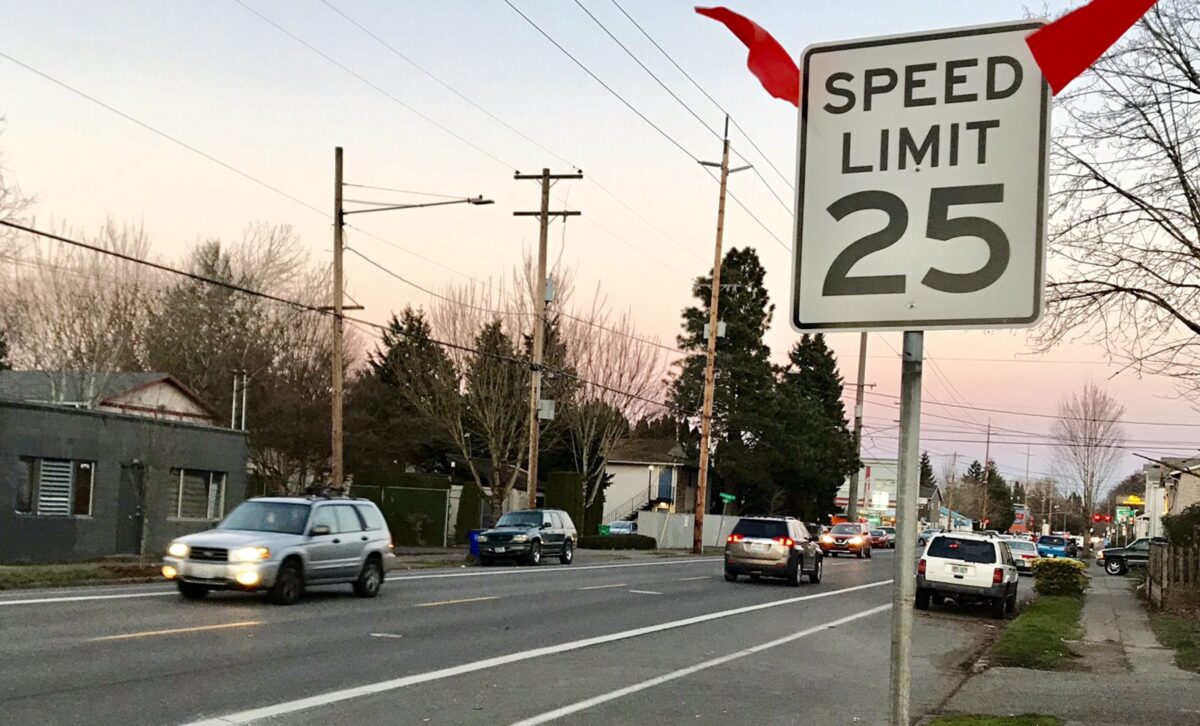
(Photo: Jonathan Maus/BikePortland)
In January 2018, armed with the fact that about half of all fatal collisions in Portland involve speeding drivers, Portland City Council passed an ordinance to, “Reduce speed limit to 20 miles per hour on residential streets to support safe travel”. It established that a designated speed (set by a local road road authority) could be set five miles per hour lower than the statutory speed (set by state law) on non-arterial streets. This led to the City of Portland’s “20 is Plenty” campaign and thousands of 20 mph signs popping up on streets citywide.
“I believe PBOT’s reluctance to comply with the ordinance on many collectors is based on fear of pushback.”
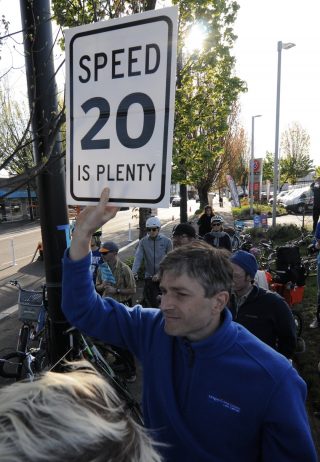
(Photo: Jonathan Maus/BikePortland)
Coming up on three years since that ordinance was adopted, Portland-based attorney and safety advocate Scott Kocher says the city isn’t fulfilling their mandate under the law and should be doing more to lower speed limits. If you’re not familiar with Kocher’s work, his firm won a settlement against the Portland Bureau of Transportation last year in a case about intersection design, and they sued PBOT back in February for failing to enforce “daylighting” at intersections. He has also written several articles for BikePortland, including a May 2019 piece about pothole dangers. (Disclaimer: Kocher’s firm, Forum Law Group, is also a financial supporter of BikePortland.)
I interviewed Kocher last week to learn more about his experiences with Portland’s new speed law and how its passage has impacted our streets. Our conversation (below) has been edited for clarity.
BikePortland: After reading your article back in January about the slow zone you helped implement with PBOT in northwest Portland, I requested 20 mph speeds on three collector streets (smaller than an arterial but larger than a local/residential street) in my neighborhood. The official denials always included this phrase, “PBOT’s policy is to maintain 25 mph posted speed limits on Major Emergency Response (MER) routes unless they are Neighborhood Greenways.” Where I live in southwest Portland, all of the collector streets are emergency response routes. What do you make of this? Does that response conform to the new law?
Kocher: I don’t know if PBOT is still telling people that, but they shouldn’t be. When I heard they were saying that a couple years ago, I met with the Portland Fire Bureau (PFB). Common sense tells us speed limit reductions don’t affect emergency response. And that’s correct. Emergency responders can activate sirens and lights, and the posted speed does not limit how fast they can go. In the more distant past, they were limited to 10 mph over the posted speed. That’s no longer true.
If anything, first responders can navigate streets more safely if other drivers are not going as fast. For example, the distance required for an emergency vehicle to pass is shorter, the closing speed of oncoming vehicles is less, and it takes other drivers less time to pull over. It’s possible some people are confusing speed limit reductions and physical measures to calm traffic. Those can have emergency response implications, which have been worked out between PBOT and PFB over the years.
Advertisement
BikePortland: PBOT installed it’s final 20 mph sign about a year and a half ago. What’s happening with “20 is plenty” today?
Kocher: I was dismayed when PBOT announced they put up their last 20 mph sign. I don’t think that’s actually true and this gets into the discussion about collectors, because the language of the ordinance is not limited to local service (also known incorrectly, Kocher warns below, as “residential”) streets.
Although people often refer to the ordinance as the “20 mph” ordinance, it actually is a five mile per hour reduction off of “the statutory speed on non-arterial streets in residence districts”. And so it obviously applies to local streets and collectors.
“The City is still making some progress with speed limit reductions… In terms of broader change, it seems we’ve mostly stalled out.”
BikePortland: And yet I keep running into the belief that the five mile per hour speed reduction applies only to local streets, that it excludes all the collector streets in residence districts. Even the recent Portland State University speed study solicited by PBOT incorrectly stated: “The Portland City Council approved an ordinance reducing the speed limit on all residential streets to 20 mi/hr in January 2018. A residential street is a street that is in a residence district according to ORS 801.430 and has a statutory speed limit. Federally classified collectors and arterials are excluded.”
I’m starting to feel gaslighted. Is PBOT fully complying with Portland’s speed reduction ordinance or not?
Kocher: The City is still making some progress with speed limit reductions, but it’s happening now on a painstaking street-by-street, segment-by-segment basis. In terms of broader change, it seems we’ve mostly stalled out. I’ve gone through the speed setting laws and city ordinance to show what is left to be done in terms of speed limit reductions within Portland just to effectuate the laws and the ordinance already on the books.
Here’s what I think we’re still missing in terms of implementation:
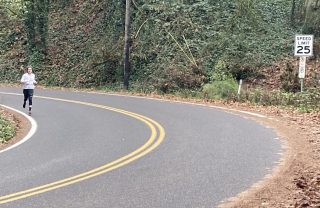
(Photo: Lisa Caballero)
Collectors in residence districts. All collectors in northwest are now posted 20 mph. In other parts of the city they’re not; but there’s nothing in the ordinance that allows PBOT to limit its implementation of 20 mph on collectors to northwest. PBOT messaging that the ordinance applies to “residential streets” is unhelpful. “Residential streets” is not a category in the ordinance or in state law. The categories are “local”, “collector” and “arterial” for what we think of as small, medium and large streets, respectively.
I believe PBOT’s reluctance to comply with the ordinance on many collectors is based on fear of pushback. That’s not a basis for PBOT to deny people who live on those collectors the level of comfort and safety that they’re entitled to. People in east and southwest Portland in particular have expressed concerns to me that collectors are streets where people have to walk and cross, and they don’t have sidewalks or signals. A lot of them are designated City Walkways and City Bikeways in Portland’s Transportation System Plan. Yet, we have people walking, rolling and biking in the same lane with people driving cars and trucks too fast. Nine of the 48 crashes that killed pedestrians in Portland from 2017-2019 were on collectors.
The City adopted Vision Zero, not Vision Nine, or twenty, or fifty. If the City is serious about turning around our crash numbers they need to stand up for the ordinance and implement it, not hide from it.
15 mph in school zones, which is 5 mph slower than their statutory speed of 20 mph. Most school zones are also in “residence districts” (as defined in ORS 801.430).
Advertisement
20 mph for any non-arterial street that is in a residence district and is also “in a public park.” I’m unaware of any legal guidance relating to whether this applies to streets along parks, say where there is a park on one side and residences on the other. 20 mph would be 5 mph slower than these streets’ statutory speed of 25 mph. As an aside, I am aware of some streets through parks, such as NW Cornell through Forest Park, that PBOT has not tried to reduce even to 25 mph.

(Photo: Lisa Caballero)
Narrow residential roadways. I think there’s a huge opportunity here. “Narrow residential roadways” are streets in a residence district where the portion of the street “that is improved, designed or ordinarily used for vehicular travel, exclusive of the shoulder” is not more than 18 feet wide (ORS 801.368). That means all Portland streets in residence districts that are 18 feet or narrower — not including shoulders or parking — must be posted 10 mph. And it means more than that. It means that we can achieve 10 mph on many more streets at low cost.
This is a big deal! Even if the pavement on your street is wider than 18 feet, it can be striped with a fog line, or furnished with planters, benches, etc. that limit the “used for vehicular travel” portion to 18 feet. Doing so means it can be posted at 10 mph. With a design speed of 10 mph, all sorts of traffic calming becomes possible… adding basketball hoops, street tree plantings, benches and the like would be transformative on a lot of the smaller streets throughout Portland.
A few times in the past, PBOT has floated the idea of striping walking space on streets with no sidewalks. Those plans were met with a chilly reception because the designs were based on 25 mph speed limit and people imagined drivers crashing head-on, or swerving into the walking lane at high speed. At 10 mph though, designs like that become a far more interesting option.
BikePortland: Thanks for sharing this with us Scott. Keep us posted on the work you’re doing.

— Lisa Caballero, lisacaballero853@gmail.com
— Get our headlines delivered to your inbox.
— Support this independent community media outlet with a one-time contribution or monthly subscription.

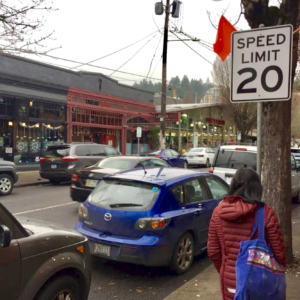
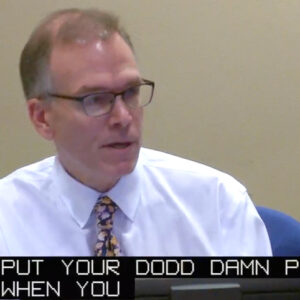
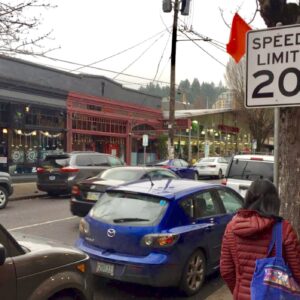
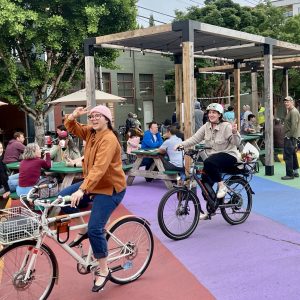
Thanks for reading.
BikePortland has served this community with independent community journalism since 2005. We rely on subscriptions from readers like you to survive. Your financial support is vital in keeping this valuable resource alive and well.
Please subscribe today to strengthen and expand our work.
Wow, amazing reporting, Lisa! I had no idea that we were missing out on lower speed limits on collectors and narrow streets. Thank you for working to make your neighborhood safer.
Thank you for the nice words, Joseph, most credit goes to Scott, who is very generous with his time.
I remember a Gary Larson cartoon in The Far Side from decades ago. It showed three cows grazing, one of them looks up with startled eyes and says, “Hey wait a minute! This is grass! We’ve been eating grass!”
I think many of us are at a “We’ve been eating grass!” moment regarding exposed walkers and riders, and speeding cars. Once you have the realization about how nuts it is, it’s hard not to speak up.
They could lower the speed limit City wide tomorrow, but if there’s no enforcement, like there is now, then it won’t matter at all. In my neighborhood I’m shocked, really shocked, when I see someone going even close to the 25 mph limit on the main street (it used to be 35).
I disagree that it “won’t matter at all”. There is a lot more to speed limits than the behavior of drivers. A few things to consider: The legal system and insurance companies use speed limits to make determinations about who was at fault. Lower limits mean less wiggle-room for speeders in making their case to a judge/agent. Also, design speed is a real thing. In some cases, engineers can/can’t do certain things based solely on the number on that sign. Also, there’s the fact that we have some local research (linked in this article) that shows lower limits do lead to less top-end speeders. Also, IMO culture is a massive factor in the speeding problem, and when governments come together to make speed limits lowing they are sending a signal that speeding is not acceptable. Obviously some people will always be assholes and speed, but I strongly disagree with the idea that “speed limits won’t matter”.
SolarEclipse is right. It will make no difference. Your argument that the lower speed limit will be used to make determine fault or be used in court cases is nonsense. No one has ever admitted to exceeding the speed limit and a case will not go before the judge because the cops will not enforce the speed limit so it will never go to court.
Your recent article about speed showed that, except for a slight reduction of really fast drivers, there was little effect from posting streets 20 mph. The effect will be the same (virtually none) with the next round of reductions.
We’ve got to at least try enforcement.
OK. I’ll agree to disagree then. And just to be clear, I’m not anti-enforcement and we are not currently doing zero enforcement. Enforcement happens still and it should happen still, we just need to figure out how to do it fairly.
One solution is to have Traffic Enforcement do the work. Their stats do not show obvious bias.
Reference/link?
From something I posted in a different article on the topic:
Data from 2018 report, available here: https://www.portlandoregon.gov/police/65520
(I haven’t looked at the 2019 report, which hadn’t been published when I wrote the above; I know the stats roughly held for other years I examined at random.)
That is certainly an odd way to frame it. Shouldn’t you be comparing the stop rates with the driver rates? Otherwise you seem to be implying that the minorities who are more likely to get stopped in this city are getting stopped because they are dangerous drivers, or that police can somehow predict who is going to get injured and are stopping those cars.
If a particular group, say young males, drives more dangerously than another group, you would expect that they would both have more crashes and get pulled over more frequently because of their driving behavior.
So, in a way, one can predict who will crash more based on how they drive. That’s why I would expect that traffic stops mirror crash rates in an unbiased system. And that is what the Traffic Division data reveal.
You are ignoring several important factors that aren’t captured in the data:
1. Safety of vehicle driven. This tracks with socioeconomic status.
2. Safety of roads driven on.
You’ll notice a lot of differences in both the roadways and the vehicles driven going from outer-east Portland to inner SE or the West Hills. Are you arguing that the higher rates of injury crashes in outer-east are due to the behavior of the drivers in that quadrant?
“Safety of roads driven on” is a reflection of how people drive on them, so I would not expect that to change the crash statistics relative to aggregate dangerous driving behavior. (i.e. the road may tempt you to speed, but you’re still speeding, which makes it more likely you’ll crash or get a ticket.)
“Safety of vehicle driven” could be a factor; is it sufficient to account for the data we have? I doubt it, but I’m happy to consider any evidence that would support your hypothesis. A good place to start would be showing that there is actually a “safety gap” in vehicle choice between demographic/geographic groups, and then we can discuss whether that could account for a doubling in injury rates.
I am arguing that the data do not show that the traffic division is stopping people in a biased manner. And yes, it entirely makes sense that differing crash rates are due to differing behavior.
Well I’m afraid the Traffic division is no longer (or near so). The PPB just today announced plans to transfer 20 Traffic officers to patrol.
https://www.portlandoregon.gov/police/news/read.cfm?id=271391&ec=1&ch=twitter
SolarEclipse and J_R— enforcement disproportionately negatively affects people of color for a variety of reasons, and if you look at the situation through that lens, it becomes unconscionable to support policies that statistically increase their exposure to the police. Morally speaking, focusing on enforcement very literally trades the safety of people of color in general for the safety of the average walker, biker or motorist. Economically speaking, fines also disproportionately affect those with lower income, and so again, support for policies that statistically increase their exposure to courts and fines can’t be the answer if our goal is to increase the comfort, safety and well-being of everyone who lives here.
Note— I sit on the Board of Oregon Walks with Scott K.
Look at who is getting killed in traffic crashes. In this context, the “average” walker/biker/motorist is more likely to be a person of color. So what we’re really doing, morally, is trading the safety of dangerous drivers for the safety of people walking in the same communities. That doesn’t seem like much of a bargain to me, and is a surprising position for an erstwhile supporter of people walking to take.
I really don’t see the moral problem with issuing traffic fines to people who deliberately endanger others, regardless of their level of income. One can (and should!) avoid fines by driving safely and legally.
Maybe traffic, and other, fines should be a percent of yearly income? Do X, and it’s a 1% fine, do Y, and it’s a 0.5% fine, etc.
Enforcement doesn’t have to affect anyone badly. It just needs to be done differently. We need enforcement officers who are:
Then there will be no reason for threat of violence on either side and it can just be simple traffic enforcement as it should be.
I used to think that too until I watched some videos of traffic stops that went off the rails. Sometimes it is the officer who escalates, but usually he just wants to issue a ticket and get out of there, and the driver (or occasionally a passenger) flips out for some reason.
Sending an unarmed officer to confront a possibly armed, possibly high, possibly irate and irrational person no longer seems like a good idea to me. I assume that you are not volunteering to do this yourself.
You can be the first unarmed officer to pull over the weaving 1980 Ford pickup out in Gresham at 11pm on a Saturday. Good luck arresting that guy for DUI without getting murdered.
I understand that people with outstanding warrants are more likely to fear police officers and that traffic stops involving people with outstanding warrants are more likely to escalate to conflicts. But who would you have enforcing warrants if not patrol officers? Doesn’t someone have to do it?
Got it. Better to let more people be killed than for a non-privileged person to be negatively impacted.
I appreciate your words on this and yes I’ve been trying to tell White folks who are well-off in Portland that their Pro Bike policies put an undue burden on non-college educated black people and especially when you want hard enforcement on drivers of course they’re going to pull over black men like myself first but of course most people do not want to hear from black men especially on this forum
Hi Kareem,
Thanks for your comments. I appreciate your perspective.
So does this mean you support higher speed limits and less enforcement of traffic laws?
J_R, I disagree with your interpretation of the recent PBOT/PSU speed study. With statistical significance to the 95th confidence interval, the study showed that:
I think those are meaningful reductions that show that the five mph has achieved slower speeds.
I think you are misunderstanding the report – specifically the “95 percent statistical significance” part. The 95 percent confidence interval refers to the average speed. The statistical significance of the whole cannot be applied to the individual components. I don’t think there were anywhere near enough samples of the higher speeds to draw a statistically valid conclusion about the significance of the somewhat lower number of speeders at high speeds.
J_R I am looking at page 4 of the PSU report, which Jonathan links to in the last line of his piece (and I link to Jonathan’s article). On that page the authors report the percent reductions for the over-25, -30, and -35 bins, and state, “All reductions were statistically significant at the 95th confidence interval.”
On page 18, they calculate the percentage reduction for each of those bins which is, respectively 15.9%, 33.6% and 49.6%.
I think that a reduction by half of the number of drivers going over 35 mph is meaningful and important, as are the 34% and 16% reductions for the other speed bins. The authors conclude, “Based on the data, there is evidence showing that the speed limit reduction significantly decreases the odds of observed high speeds.”
I forgot to add, the pooled sample sizes were 143,389 observations of individual cars before and 90,075 cars after lowering the speed to 20 mph. (p. 3 of study)
I stand corrected. Thanks for the reference.
I find it very disheartening white people like yourself always make rules that effect people that are less educated and less financially well-off have you ever thought to yourself the rules you’re making makes it harder for black people to own cars in Portland
What kind of traffic rules would you like to see? Certainly not higher speed limits and less enforcement… that would just lead to more crashes.
Does anyone know why PPB doesn’t enforce traffic laws when it would be so easy to do and could be so lucrative? Perhaps things would change if the PPB budget was based on traffic fines?
PPB gets accused of racism if they do any enforcement. It’s not worth it. The community reaps what it sows.
They don’t have the staff and they don’t get the money – Portland get zero money from traffic fines
SolarEclipse, Scott and I talked about enforcement. We talked about it so much that it needed to become an entire second interview. It’s something he has thought a lot about, and he has sensible, sensitive ideas. Hopefully, BP can run a 2nd interview in the not too distant future.
Please do. I’d love to hear the ideas.
@SolarEclipse, I hear you about drivers not going the speed limit. I see lowering the posted speed and engineering to achieve it as chicken and egg. Here’s an example: we tried to get a marked crosswalk and a refuge island installed on a collector that has a 1,400-foot straightaway and therefore, predictably, most drivers speed. The length of the “taper” for an island is longer at 25 MPH than at 20. (At 20 drivers are presumed to be capable of making a modestly more abrupt meander around the refuge island.) At 25 MPH the longer taper for the island is more likely to affect vehicle access to a driveway, and might involve removing an extra parking spot. One extra person complaining about those things could easily make or break the project.
Unfortunately for my neighborhood we have a 1 mile long straightaway, with no stops, no islands, no nothing. I now avoid that street entirely when I go for my neighborhood walks. I’ve seen that PBOT (I presume) has put in a street counter device on one of the side streets, but not the main “drag” (and I mean that literally). So maybe there’s something in a traffic calming sort of way going to happen in the future, but it’s well away from our drag strip.
Pre-COVID when the street was changed from a 35 to a 25 people seemed to do pretty well. I’d say many went 30 – 40 and people were coming to complete stops at Stop Signs. When someone would actually run a stop sign it would be unique enough that I’d mention it to my roommate when I got home.
Now with COVID, and the City government and Police, saying they aren’t going to be enforcing the “minor” infractions, only those that are life threatening, well my neighbors got the message loud and clear. Now in COVID, when I see someone actually going near the speed limit of 25 I actually take note as that is the exception. Speeds of 40 – 50 are now routine. As for Stop signs, now it’s when I actually see someone come to a full stop that I take note and mention it to the roommate as people are running them like they don’t exist anymore (for awhile I was actually checking that the signs were still there, and they are).
So until enforcement comes back it’s a nightmare in my neighborhood.
So when someone comes and talks about how great and wonderful reducing the speeds have been, well those stats were pre-COVID so this is a whole new world out here on the mean streets of Portland. Changing the signs without an enforcement component is a lost cause in my opinion.
Well enough of my ranting and raving . . . back to your regular bike news . . .
Get ready for even more speeding. Due to budget cuts, overtime costs due to protests and increased police retirements (who would want to be a cop in Portland?) the PPB is shifting 20 Traffic officers to patrol.
Today’s announcement:
https://www.portlandoregon.gov/police/news/read.cfm?id=271391&ec=1&ch=twitter
I disagree that “it won’t matter at all”? It may not make much of a difference on some streets, but it certainly has made a difference on others. Every single one of us who abides by the lowered speed limits affects change for not just our own vehicles, but also for those around us. I have also noticed that it takes a little time for the overall behavior of drivers to change after the posted speed limit has been reduced. Lowered speed limits on two streets I use frequently, Davis St and Hawthorne, have made a noticeable difference.
I disagree with Solar Eclipse, but I do agree with Brian.
While driving on Ainsworth, I used to go 30mph with a line of cars behind me… And today on NE Ainsworth while driving or riding my Ebike, I go 20mph with a line of cars behind me.
Oh the irony that this conversation is happening now.
This morning I was up early enough that I thought I’ll go ahead and walk down my dangerous main street. I had about 6 cars pass me. What I did notice, and I got a HUGE LAUGH from, was seeing brand new speed limit signs with the orange flags on top. My main street is now 20 mph!
/sarcasm-on
Wow, as soon as I saw those all my fears and trepidation went away. How much safer my street is now. It won’t matter that the City isn’t enforcing laws anymore, my upstanding neighbors will see those new signs and start being safer. It’s like a whole new world in my neighborhood!
I bet back at PBOT virtual HQ the Champaign corks were popping and pats on the back all around because they made SolarEclipse’s street safer!
/sarcasm-off
Don’t get me wrong, under normal circumstances seeing that report I’d be like “yeah, it’s working”. But to me that data in the report was taken a life time ago. It is no longer valid. Who knows maybe only my neighborhood has a cluster of speeders and stop sign runners that the rest of the City doesn’t.
PBOT should do their survey now and see how the streets are doing under the non-enforcement policy we live under now and don’t wait over a year to release the information.
Guess how many of those 6 cars were going 20 mph . . . Zero, Nada, Zilch.
Yeah, Zero Vision, oh feel the awesomeness of it!
10 mph streets seems like an opportunity for the barnum and balzer circus to write speeding tickets to bicyclists.
Only if you are going faster than 21mph. The Oregon court system generally assumes that 10 mph over the speed limit is okay. That’s why we need 10mph streets: with 20 mph you can go up to 30 mph with no risk of a ticket and will probably not be blamed in a collision, and there is a big difference in risk of death when a vehicle collides with someone at 20 mph instead of 30 mph: https://usa.streetsblog.org/2016/05/31/3-graphs-that-explain-why-20-mph-should-be-the-limit-on-city-streets/
You seem unfamiliar with the barnum and balzer circus, a crew who certainly will write tickets to bicycles going 11 mph if given the opportunity. They are definitely on the list of why all speed enforcement should be automated, which would also eliminate the issue of ridiculous bicycle speeding tickets.
we should write a law at x, because we all know that enforcement begins at x+10 is one of the slipperiest slopes in the history of mountaineering.
The info about 10 mph being required for narrow residential roadways is incredibly timely for me. I just made a request on behalf of several neighbors to PBOT to change the speed limit on their narrow street “from 20 mph to 15 or even 10 if 10 is allowed”. PBOT responded that 15 was possible, but their response didn’t even address the possibility of 10 mph.
I asked for 10 because I remember reading in a past article here that it was possible in certain instances. Now I read here that 10 isn’t just possible, it’s required (!). Now I have more ammo when PBOT calls me back. Of course now I’m wondering why PBOT wouldn’t acknowledge that 10 was possible, especially when it may actually be required.
It may have more to do with placing too many signs. If every intersection had 4-way stop signs as richer neighborhoods frequently request, then all drivers (and cyclists) would gradually get into the habit of ignoring all stop signs, even those at dangerous intersections, leading to more crashes. It’s the same with speed limit signs – regulatory signs should be placed where they’ll most likely have an impact, but not everywhere.
That may be true, but it’s irrelevant. PBOT already sounds receptive to putting up the signs. The only issue is whether they’d be for 15 MPH or 10.
Why should I follow a speed limit? The far left have created a sentiment of no personal responsibility in Portland. Of course drivers sense this, even if it’s subconsciously. Here in Portland, one does not need to pay their mortgage, one can break windows and vandalize at will. One can attack law enforcement officers and physically intimidate elected officials if you feel like it. You don’t need to register your car. You can camp anytime anywhere and leave your garbage and needles wherever you want. Lawlessness is the order of the day. Why would I follow a speed limit?
I don’t understand most of your comment, Pascual. Can you interpret for me? Who are the far left? how have they create this sentiment that I don’t see?
You sir are engaging in hyperbole
Nope
20mph? 10mph? I thought Portland was “progressive” and yet no one takes my 0mph plan seriously! You think reducing the speed limit by 5-10mph is enough? Not hardly. Think of all the lives we could save if the speed limit were set to nothing. It would be a breeze to enforce as well. “If it’s moving a bit, ticket it!” is my catchy slogan. Just give it a chance is all I ask.
You need a catchier slogan. How about “None is fun!”
“none is fun” love it! And this goes well with my contention that speed is always a factor in a collision if someone is going over 0 mph.
This lawyer is nuts. 20 mph on that road in the picture with no houses around? 15 mph when you will be overtaken by Tour de France bikers left and right? Basketball hoops? Is this “greeny” on crack? Why dont we teach some bicyclists basic traffic manners that a stop sign also applies to them? Then get back to me.
You clearly don’t know that road. And the human in the picture is what we want to protect not the houses on the side of the road of which that road has many.
For almost a year now, stop signs don’t apply to cyclists in the same way they do to cars. There’s a law about it and everything. Why don’t we have drivers show that they know the rules of the road more than just the first time they get their license? Then get back to me.
@Realist Please take the time to study Oregon traffic law before operating a motor vehicle within the state. Oregon law, Washington too actually, permits a person riding a bicycle to treat a stop sign as a yield sign.
Portland, of course. A leftist paradise.
Yep. It’s a great place to live! We really like it here.
It’s Utopia for college-educated white people so they can ignore the harm their policies do to others below their station
Good Lord. How are you guys still pursuing this vision zero nonsense. Nearly every city that has tried to implement this absurdity has failed. If limits are set to 10 then guess what? 100% of accidents will be “BeCaUse Of sPEeDiNg”, and then we’ll see articles claiming we need to lower limits to 5mph (fOr sAfeTy! Won’t someone think of the children!)
Please just admit you hate people that have to drive and don’t have the luxury of riding a bike. Until it’s stops raining in Portland, until public transit is as fast and convenient as driving, driving is going to exist. Let’s please stop pretending that arterials and collectors should be safe for children to play in. Physics doesn’t care when it’s 2 tons of metal versus a bag of bones. Unless everyone drives 5 mph that is a fact of life. Let’s get our head out of the sand people.
Waiting for all the predictable “yes 5 mph is great!” replies smdh
Unless we change the law, a 10mph or 5mph limit applies to bicycles, too. At at those limits, it would mean a lot of cyclists would have to consciously pay attention to their speed to remain under, to say nothing of e-bikes.
Crashes between bags of bones and tons of metal could be much more survivable than they currently are. Speed is a big factor in that survivability, so it makes sense to regulate it to a more survivable maximum in areas where bags of bones and tones of metal need to coexist — i.e. local and collector streets. Where speeds are higher (arterials) we should be advocating for safety through other means, like protected spaces. I don’t know about zero, but can we at least agree to aim for fewer deaths than we have right now? Are you willing to tell someone’s family that it was what — too inconvenient — to adopt a policy that might have saved their loved one’s life? And more importantly, how *do* we strike that balance? I’ve been struggling with that question for years. It’s easy to talk in extremes (like 5mph, or why not 0?), but I think we can nearly all agree the answer is neither a speed limit of 5 nor 50. How do we find the appropriate in-between?
20 seems like a pretty good compromise in most residential and commercial contexts. The trick, of course, is getting people to obey the limit.
You’re skipping the essential part of the question — why 20? Let’s assume 100% compliance because that’s a whole separate discussion. But what makes 20 right? Why not 15? Why not 25?
To be precise, I want to get away from the “this is what feels right to me” aspect that so often taints these discussions, because what feels right is no basis on which to get a bunch of diverse people to agree on something controversial. I’m desperately in search of a framework that takes some of the “feel” out of choosing a particular number. I don’t pretend to want to remove subjective assessment entirely, but rather move it from picking a number to picking the principles and methodology that generate “the number”.
I choose 20 because is what feels right to me; it seems like a good balance between allowing people to get around and compatibility with residential areas. If you have 100% compliance, 25 would probably be ok too.
If you wanted to be more rigorous about it, you’d probably want to model cost and safety and find figure out where the min-max was. At some point the speed/safety curve is going to flatten, and that’s where I suspect you’d find your optimum.
Waiting for you to mention a number of traffic kills you think is OK.
Picking a number without the context of the cost of achieving it and the various trade-offs involved is a pointless exercise. Safety is an optimization problem, not something that can be evaluated in isolation from other factors.
A person who thinks zero is unattainable / too expensive can be asked, how many deaths are acceptable, or how much money is too much?
Any person who thinks zero is realistic can be asked, how many dollars should we spend and how many other life-saving initiatives should we forgo to save the next marginal traffic fatality? By number of deaths, heart disease is more than an order of magnitude worse than traffic fatalities. Why are we spending money on traffic at all when there’s a so dramatically worse and just-as-preventable cause of death happening? (Completely fictitious hypothetical here…) Why would any rational person spend $1M on traffic to save 10 lives when they could spend $1M on heart disease to save 100 lives?
Thus I return to my earlier claim: discussing in extremes isn’t useful. How do we agree on what’s achievable and the most good given the actual reality we face?
If you want to save lives in bulk, forget heart disease… spend that $1M on fighting malaria.
I take your point. Inexpensive medical interventions can make lives better and I’m absolutely in favor of broadly available medical care if only to reduce the cost of dramatic and expensive care for people who have no other resource. Paradoxically we have decided that people cannot be denied heroic treatment at the end of life but preventative medicine is much more difficult.
Every person born is going to have a little heart problem at some point but at least we can manage it.
I support investment in improved safety for people travelling in the context of highway widening projects that cost billions and have ephemeral benefits.
NO MORE TRAFFIC COPS IN PORTLAND!
As reported by bike portland
BikePortland
@BikePortland
·
Dec 11
“The moves… leave no other officers dedicated solely to traffic patrols, said Sgt. Kevin Allen.”
Link to article on elimination of Traffic police
https://www.oregonlive.com/crime/2020/12/portland-police-to-move-traffic-officers-canine-cops-to-patrol-next-year-to-fill-shifts-cut-overtime-and-improve-response-times.html?utm_medium=social&utm_source=twitter&utm_campaign=oregonian_sf
Why bother! Drivers don’t observe the speed limits we have now and there’s no enforcement in this town.
You haven’t seen nothing yet. As of the first of the year there will be no longer be any traffic cops thanks to the police defunders. It will get worse. Maybe we should change the slogan from Vision Zero to “Vision oh well, f@&# it!”
The word is definitely out there amongst the criminals that it’s open season in Portland as the City & DA won’t do anything.
No doubt. District Attorney Mike Schmidt’s anemic response to illegal behavior has helped stoke the fire of criminality.
Not to mention Ted Wheeler’s recent apology to the “sovereign citizen” family illegally occupying the red house on Mississippi. He felt he needed to apologize for telling them they needed to follow the law. Wouldn’t want anyone to actually be responsible for their own actions, would we?
Well, stay safe and ride on!
I’m not often a defender of Ted Wheeler but you’re misconstruing his apology here. Wheeler wasn’t apologizing for enforcing the law, he was apologizing for how his words caused intimidation and threats of violence against another person.
Well get ready for more armed leftist takeovers of private property in Portland due to Wheeler’s capitulation.
Everyone put up your BLM sign. Hopefully it will protect you from the mob.
https://www.oregonlive.com/portland/2020/12/portland-black-indigenous-family-red-house-protesters-aura-of-success-could-prompt-more-occupations-over-home-foreclosures-mayor-ted-wheeler-concedes.html
That sounds pretty reasonable to me. The lawless takeover has been abated without CS gas, federal goon squads, or excessive violence. Outside descriptions of what each side wants make it sound like an agreement can be reached; it just needs time to happen.
I understand the worry that someone could think the hostile takeover is what led to this resolution rather than an offer to buy/sell. (Granted, the takeover drew the attention to fund the offer.) But the kind of forceful police response I think you’re saying you would have preferred would see us in a much worse state now — probably with nightly conflicts, sizeable protests about excessive police force, more overtime, likely injuries, and further from resolution than we are today.
We’ll see what happens if there’s a next time. I hope there isn’t. Wheeler has made it clear that this isn’t going to become a recurring pattern, although the alternative if people try is probably a forceful response that is also distasteful for all the reasons we’ve vividly experienced this year.
I’m relieved the situation looks to be resolved peacefully. It was unusual in that it could be resolved with the simple application of cash, and there were enough people willing to donate to make that possible. It’s not a solution that will scale.
There will be no traffic enforcement detail. Maybe. There will still be cops and they are all empowered to enforce traffic laws. It’s a bit strange that we have officers put into silos where they only do one thing. It’s crazy that we put such limits on photo enforcement. It’s appalling that vehicle owners can avoid financial responsibility for traffic offenses committed by someone using their car.
Portland should do this. In Minneapolis and St. Paul we’ve just done the same, with residential streets reduced to 20 mph (insanely, they were 30 mph previously!) And no, our residential streets are not any wider than Portland’s, with 35′ being the most common width, and many streets at 25′ and occasionally 20′,
Most city-owned arterials are reduced to 25 mph, similar to what’s proposed for Portland. County and state-owned arterials are still higher, since the cities don’t have direct jurisdiction over them.
The signs they are a-changin’.
Update/correction re the city’s authority to reduce speeds in parks. There’s a special subsection in the statutes just for that. It’s easy. And they can go as slow as they want:
From: Scott Kocher
Date: April 4, 2021 at 6:30:08 PM PDT
To: [various City of Portland recipients]
Subject: Please reduce park speeds
Dear City of Portland,
Would you please exercise your authority under ORS 810.180(7) to lower speeds on streets in Portland parks?
With streets in parks currently posted 20 to 35 MPH, and actual speeds typically 5 to 10 MPH faster, our parks are often not safe or inviting places. Uniform park-wide speeds of 10 MPH would be consistent with these areas serving as a refuge—generally our only refuge—where people of all ages, and especially parents, don’t need to worry about anyone getting injured or killed by people driving.
Portland can make all parks 10 MPH simply by its own adoption, without involving ODOT or any other outside agency. The text of ORS 810.180(7) is below.
Thank you,
Scott
(7) A road authority may adopt a designated speed to regulate the speed of vehicles in parks under the jurisdiction of the road authority. A road authority regulating the speed of vehicles under this subsection shall post and maintain signs at all park entrances to give notice of any designated speed.
Scott F. Kocher
Forum Law Group LLC
811 SW Naito Pkwy, Suite 420
Portland OR 97204